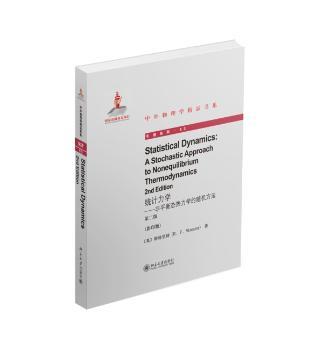内容简介
《统计力学——非平衡态热力学的随机方法(第二版)(英文影印版)》详细地介绍了用统计力学方法处理非平衡态热力学和统计物理问题的研究。其中统计方法包含了经典统计和量子统计。本书研究对象主要为平均能量守恒和熵增的系统。探讨了热噪声、化学反应、扩散等等问题。
《统计力学——非平衡态热力学的随机方法(第二版)(英文影印版)》可作为统计物理、凝聚态物理、材料科学领域的研究者的参考书,也可供相关领域研究生作为教材使用。
目录
Preface v
Classical Statistical Dynamics 1
1. Introduction 3
2. Probability Theory 13
2.1 Sample Spaces and States . . . . . . . . . . . . . . . . . . 13
2.2 Random Variables, Algebras . . . . . . . . . . . . . . . . . 24
2.3 Entropy . . . . . . . . . . . . . . . . . . . . . . . . . . . . 34
2.4 Exercises . . . . . . . . . . . . . . . . . . . . . . . . . . . 39
3. Linear Dynamics 43
3.1 Reversible Dynamics . . . . . . . . . . . . . . . . . . . . . 43
3.2 Random Dynamics . . . . . . . . . . . . . . . . . . . . . . 48
3.3 Convergence to Equilibrium . . . . . . . . . . . . . . . . . 60
3.4 Markov Chains . . . . . . . . . . . . . . . . . . . . . . . . 66
3.5 Exercises . . . . . . . . . . . . . . . . . . . . . . . . . . . 69
4. Isolated Dynamics 73
4.1 The Boltzmann Map . . . . . . . . . . . . . . . . . . . . . 73
4.2 The Heat-Particle . . . . . . . . . . . . . . . . . . . . . . 87
4.3 The Hard-Core Model of Chemical Kinetics . . . . . . . . 94
4.3.1 Isomers and Di_usion in a Force-Field . . . . . . . 95
4.3.2 Markov Dynamics . . . . . . . . . . . . . . . . . . 100
4.3.3 Entropy Production . . . . . . . . . . . . . . . . . 102
4.3.4 Osmosis . . . . . . . . . . . . . . . . . . . . . . . 103
4.3.5 Exchange Di_usion . . . . . . . . . . . . . . . . . 104
4.3.6 General Di_usions . . . . . . . . . . . . . . . . . . 105
4.4 Chemical Reactions . . . . . . . . . . . . . . . . . . . . . 106
4.4.1 Unimolecular Reactions . . . . . . . . . . . . . . . 106
4.4.2 Balanced Reactions . . . . . . . . . . . . . . . . . 107
4.5 Energy of Solvation . . . . . . . . . . . . . . . . . . . . . . 111
4.6 Activity-led Reactions . . . . . . . . . . . . . . . . . . . . 111
4.7 Exercises . . . . . . . . . . . . . . . . . . . . . . . . . . . 119
5. Isothermal Dynamics 123
5.1 Legendre Transforms . . . . . . . . . . . . . . . . . . . . . 124
5.2 The Free-energy Theorem . . . . . . . . . . . . . . . . . . 126
5.3 Chemical Kinetics . . . . . . . . . . . . . . . . . . . . . . 130
5.4 Convergence in Norm . . . . . . . . . . . . . . . . . . . . 137
5.5 Dilation of Markov Chains . . . . . . . . . . . . . . . . . . 146
5.6 Exercises . . . . . . . . . . . . . . . . . . . . . . . . . . . 149
6. Driven Systems 151
6.1 Sources and Sinks . . . . . . . . . . . . . . . . . . . . . . 151
6.2 A Poor Conductor . . . . . . . . . . . . . . . . . . . . . . 152
6.3 A Driven Chemical System . . . . . . . . . . . . . . . . . 155
6.4 How to Add Noise . . . . . . . . . . . . . . . . . . . . . . 162
6.5 Exercises . . . . . . . . . . . . . . . . . . . . . . . . . . . 165
7. Fluid Dynamics 167
7.1 Hydrostatics of a Gas of Hard Spheres . . . . . . . . . . . 168
7.2 The Fundamental Equation . . . . . . . . . . . . . . . . . 171
7.3 The Euler Equations . . . . . . . . . . . . . . . . . . . . . 177
7.4 Entropy Production . . .




 VIP会员
VIP会员